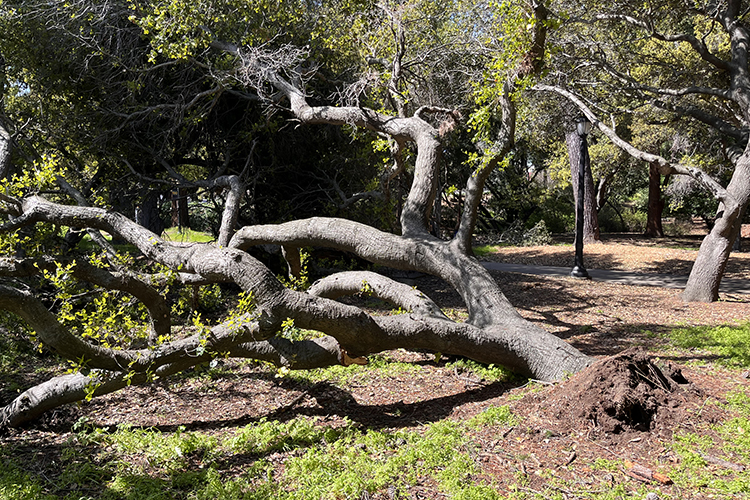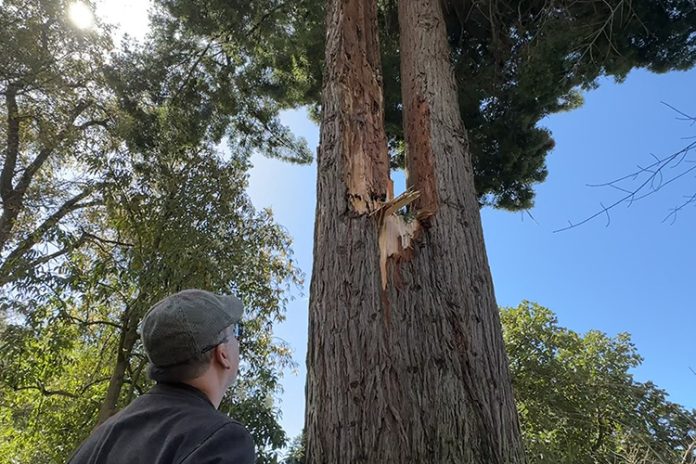UC Botanical Garden collections director Andrew Doran examines storm damage to a coast redwood believed to be over 150 years old. (UC Berkeley Photo by Marissa Gutierrez)
The loud bang came at 4:30 p.m. last Tuesday while Andrew Doran was in his office at the 34-acre UC Botanical Garden in Strawberry Canyon. It was heard despite the terribly high winds and torrential rain that wreaked havoc throughout the Bay Area that day as part of a rare so-called “bomb cyclone.”
Doran, the director of collections, went out to investigate, “but after destroying my umbrella and losing a hat,” he said, “I decided it was unwise.” He beheld the apex of the precious, high towering coast redwood (Sequoia sempervirens) on the property – older than the garden at more than 150 years – and took a picture. One of the three codominant trunks of the conifer had been sheared off.

The garden’s California horse chestnut before it was struck down by the sheared trunk of a neighboring coast redwood. (Photo by UC Botanical Gardens)
The next morning the news was more disastrous. This broken redwood trunk had landed on another garden icon, a California horse chestnut (Aesculus californica), which also lived in the country before the garden was officially established in 1890. And there was widespread damage to the garden’s plant collections, including a piece of woody bamboo (Phyllostachys bambusoides) from another of the three trunks or trunks of the sequoia, which had been blown away and flown through the air toward Strawberry Creek.
Also, one of three large endangered spruces (Picea martinezii) was damaged, as well as the top half of the garden’s only Parana pine (Araucaria angustifolia), trunks of red ash (Alphitonia excelsa) and durikai malee (Eucalyptus infera), and a gum leaf cone bush (Leucadendron eucalyptifolium).
The garden is one of the most diverse landscapes in the world – it is divided geographically into nine regions with semi-natural plantings – and is home to more than 10,000 plant species, including many rare and endangered species.
“Decades of tending and tending to some of the garden’s treasures have been destroyed,” Doran said.

This fallen oak tree on the Grinnell Pathway was among 20 trees on central campus damaged by recent storms. (UC Berkeley photo by Robert Sanders)
Meanwhile, the storms damaged about 20 trees, including oak, eucalyptus and pine, on Berkeley’s central campus.
“Most of the trees were eucalyptus trees and the primary cause was years of drought stress, high winds, saturated soil and shallow roots,” said Felix Deleon, operations manager for facility services, adding that the condition of the trees is currently being assessed.
The campus core is home to more than 13,500 trees and almost 300 different tree species.

The sequoia is probably beyond salvage and “poses a significant threat to people and plants in the area,” says Andrew Doran. (UC Berkeley photo by Robert Sanders)
The Botanical Garden is also now actively assessing the overall damage there with the help of UC Berkeley gardeners, arborists and arborists to determine what action needs to be taken. Doran said the sequoia was likely damaged beyond saving and “poses a significant hazard to people and plants in the area.”
“Removing the fallen branches and remaining trees will be a major challenge given the (steep, hilly) topography and the distance to a road where a crane could be used,” he added. “It will disturb the surviving plants (near the tree) so much that they may need to be temporarily moved.”
Staff are restricting visitor access to the site of the sequoia and horse chestnut so they can quickly document the damage — including plants under the two trees — and determine whether those plants will be pruned, propagated, saved to a new location, or not can . All parts of the undergrowth of the garden are densely planted due to the limited space.
“We have to work fast as the plants are starting to break through their hibernation and the window is closing for shipping to containers or other locations,” said Doran, adding that the work takes the staff “hundreds of hours.” become.

Barrier tape is preventing visitors to the UC Botanic Garden from approaching areas where the redwood trunk has crushed the horse chestnut in record-breaking winds and heavy rain. (UC Berkeley Photo by Marissa Gutierrez)
The coast redwood and California horse chestnut, which bore a close resemblance to the horse chestnut in Faculty Glade, had grown on land planted in the 1920s as the Asian portion of the garden.
“The loss of this coast redwood is particularly poignant given its proximity to its Asian relative, the morning redwood (Metasequoia glyptostroboides), which was planted in the 1940s,” Doran said. “Their proximity was useful in showing students and visitors the evolutionary relationships between these two species.”
Doran said that despite the damage at the Botanic Gardens, those who work there understand that “these events, though unfortunate, are part of the stewardship of a living museum,” as are duties that include keeping records of flowering and fruiting times and the documentation of the research carried out belong in the garden, taking photos and making samples.
“And if the sequoia is dissected into a stump,” he said, “it could make a good platform for interpretation.”
The garden remains open to the public seven days a week, with the exception of the first and third Tuesdays of each month.
news.berkeley.edu
https://news.berkeley.edu/2023/03/28/two-beloved-uc-berkeley-trees-over-age-150-damaged-in-bomb-cyclone/















